fuel pressure HONDA CIVIC 2022 Owners Manual
[x] Cancel search | Manufacturer: HONDA, Model Year: 2022, Model line: CIVIC, Model: HONDA CIVIC 2022Pages: 700, PDF Size: 13.98 MB
Page 114 of 700
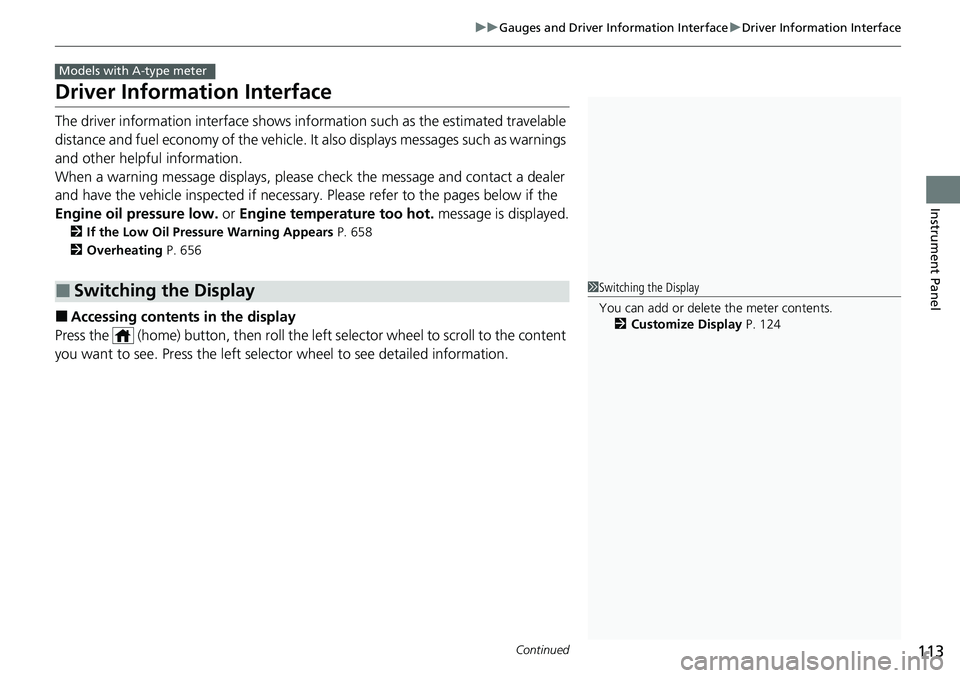
113
uuGauges and Driver Information Interface uDriver Information Interface
Continued
Instrument Panel
Driver Information Interface
The driver information interface shows information such as the estimated travelable
distance and fuel economy of the vehicle. It also displays messages such as warnings
and other helpful information.
When a warning message displays, please check the message and contact a dealer
and have the vehicle inspected if necessary . Please refer to the pages below if the
Engine oil pressure low. or Engine temperature too hot. message is displayed.
2If the Low Oil Pressure Warning Appears P. 658
2 Overheating P. 656
■Accessing contents in the display
Press the (home) button, then roll the le ft selector wheel to scroll to the content
you want to see. Press the left sele ctor wheel to see detailed information.
■Switching the Display
Models with A-type meter
1Switching the Display
You can add or delete the meter contents.
2 Customize Display P. 124
Page 139 of 700
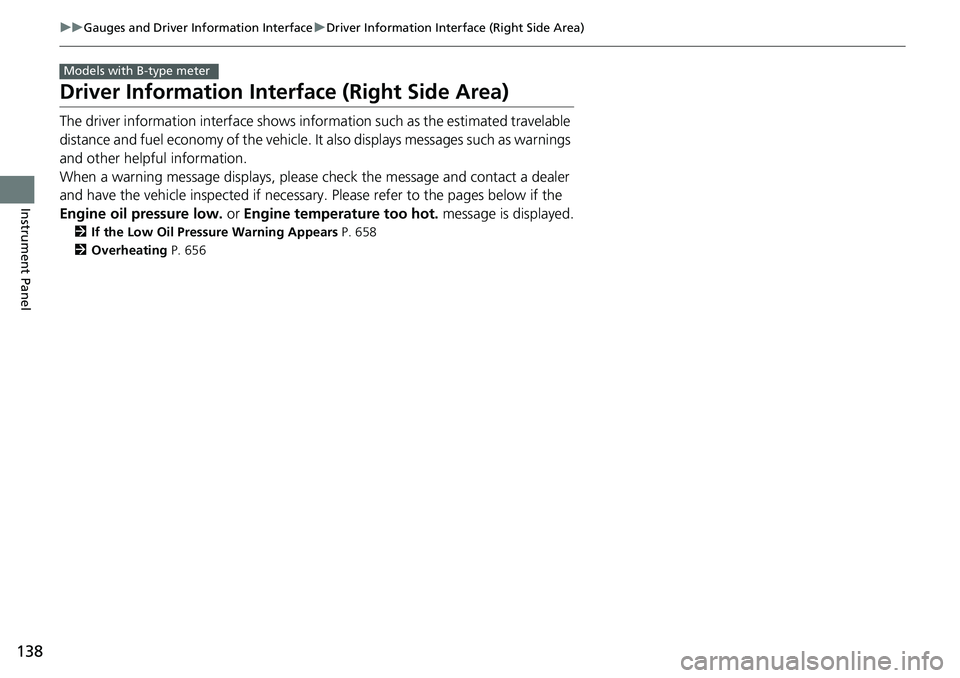
138
uuGauges and Driver Information Interface uDriver Information Interface (Right Side Area)
Instrument Panel
Driver Information Inte rface (Right Side Area)
The driver information interface shows in formation such as the estimated travelable
distance and fuel economy of the vehicle. It also displays messages such as warnings
and other helpful information.
When a warning message displays, please check the message and contact a dealer
and have the vehicle inspected if necessary . Please refer to the pages below if the
Engine oil pressure low. or Engine temperature too hot. message is displayed.
2If the Low Oil Pressure Warning Appears P. 658
2 Overheating P. 656
Models with B-type meter
Page 430 of 700

429
Driving
This chapter discusses driving and refueling.
Before Driving................................... 430
Towing a Trailer ................................ 435
When Driving
Starting the Engine .......................... 436
Precautions While Driving................. 441
Continuously Variable Transmission ..... 442Shifting .................................... 443, 445
ECON Button*................................. 449
Drive Mode Switch*......................... 450
Auto Idle Stop .................................. 453
Vehicle Stability AssistTM (VSA®), aka Electronic
Stability Control (ESC), System .............. 459
Agile Handling Assist ....................... 461
Tire Pressure Monitoring System (TPMS) .... 462Tire Pressure Monitoring System (TPMS) - Required Federal Explanation ......... 467
Blind Spot Information System
*....... 469
Honda Sensing ®................................ 473
Collision Mitigati on Braking System
TM
(CMBSTM) ....................................... 476
Low Speed Braking Control*............ 488
Adaptive Cruise Control (ACC) with Low
Speed Follow ................................. 494
Lane Keeping Assist System (LKAS).... 516
Traffic Jam Assist ............................. 528
Road Departure Mitigation System ... 537 Traffic Sign Recognition System ....... 545
Front Wide View Camera ................. 551
Sonar Sensors
*................................ 553
Braking
Brake System ................................... 554
Anti-lock Brake System (ABS) ........... 560
Brake Assist System ......................... 561
Parking Your Vehicle ........................ 562
Multi-View Rear Camera .................. 573
Refueling ........................................... 575
Fuel Economy and CO
2 Emissions .... 578
Turbo Engine Vehicle*...................... 579
* Not available on all models
Page 468 of 700
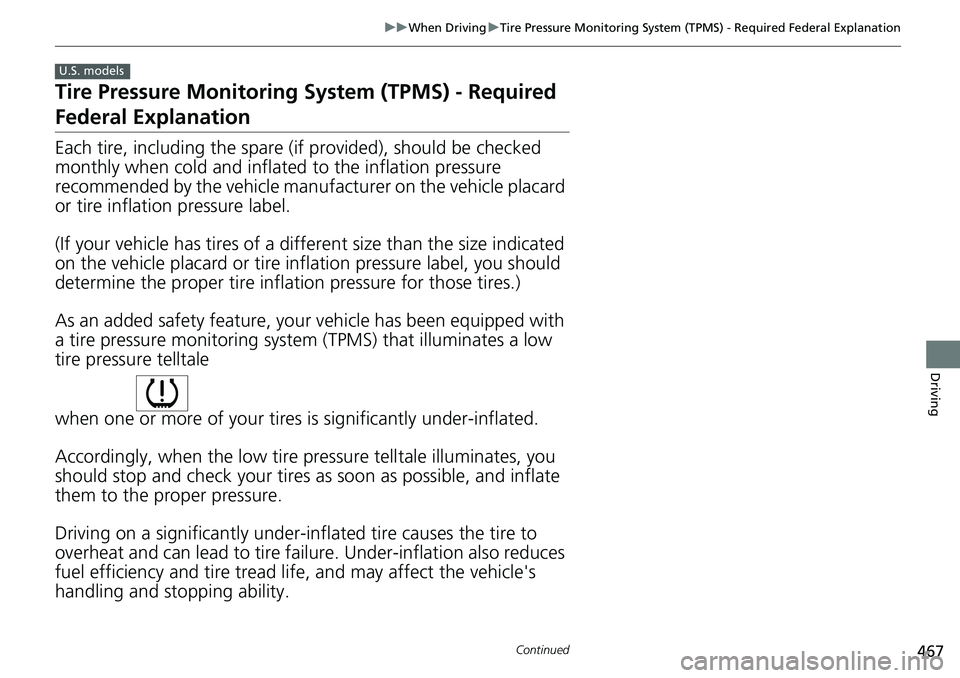
467
uuWhen Driving uTire Pressure Monitoring System (TPMS) - Required Federal Explanation
Continued
Driving
Tire Pressure Monitoring System (TPMS) - Required
Federal Explanation
Each tire, including the spare (if provided), should be checked
monthly when cold and inflated to the inflation pressure
recommended by the vehicle manufa cturer on the vehicle placard
or tire inflation pressure label.
(If your vehicle has tires of a diff erent size than the size indicated
on the vehicle placard or tire inflation pressure label, you should
determine the proper tire inflat ion pressure for those tires.)
As an added safety feature, your vehicle has been equipped with
a tire pressure monitoring system (TPMS) that illuminates a low
tire pressure telltale
when one or more of your tires is significantly under-inflated.
Accordingly, when the low tire pressure telltale illuminates, you
should stop and check your tires as soon as possible, and inflate
them to the proper pressure.
Driving on a significantly under-inf lated tire causes the tire to
overheat and can lead to tire fail ure. Under-inflation also reduces
fuel efficiency and tire tread life, and may affect the vehicle's
handling and stopping ability.
U.S. models
Page 579 of 700
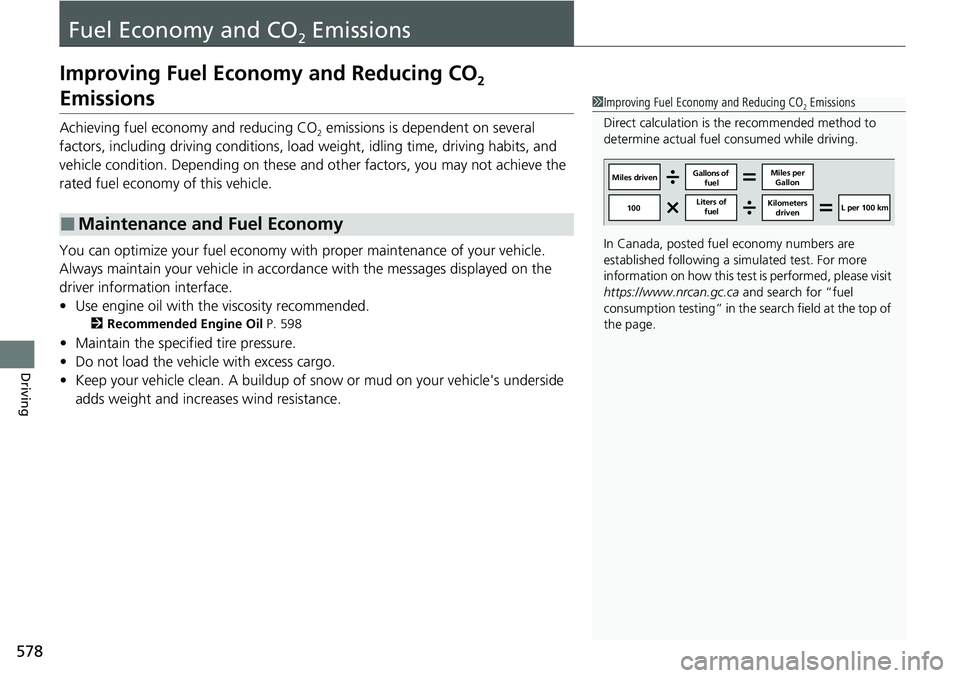
578
Driving
Fuel Economy and CO2 Emissions
Improving Fuel Economy and Reducing CO2
Emissions
Achieving fuel economy and reducing CO2 emissions is dependent on several
factors, including driving conditions, load weight, idling time, driving habits, and
vehicle condition. Depending on these and other factors, you may not achieve the
rated fuel economy of this vehicle.
You can optimize your fuel economy with proper maintenance of your vehicle.
Always maintain your vehicle in accord ance with the messages displayed on the
driver information interface.
• Use engine oil with the viscosity recommended.
2 Recommended Engine Oil P. 598
•Maintain the specified tire pressure.
• Do not load the vehicl e with excess cargo.
• Keep your vehicle clean. A buildup of snow or mud on your vehicle's underside
adds weight and increases wind resistance.
■Maintenance and Fuel Economy
1Improving Fuel Economy and Reducing CO2 Emissions
Direct calculation is the recommended method to
determine actual fuel consumed while driving.
In Canada, posted fuel economy numbers are
established following a simulated test. For more
information on how this test is performed, please visit
https://www.nrcan.gc.ca and search for “fuel
consumption testing” in the search field at the top of
the page.
Miles driven Gallons of
fuel Miles per
Gallon
100 Liters of
fuel Kilometers
driven L per 100 km
Page 583 of 700
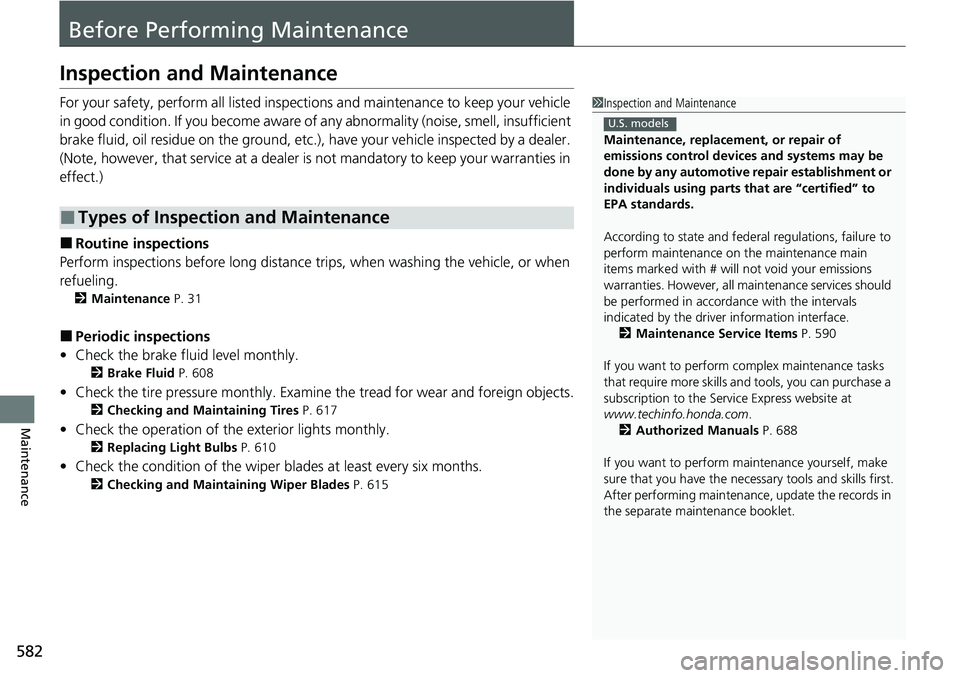
582
Maintenance
Before Performing Maintenance
Inspection and Maintenance
For your safety, perform all listed inspections and maintenance to keep your vehicle
in good condition. If you become aware of an y abnormality (noise, smell, insufficient
brake fluid, oil residue on the ground, etc.), have your vehicle inspected by a dealer.
(Note, however, that service at a dealer is not mandatory to keep your warranties in
effect.)
■Routine inspections
Perform inspections before long distance tri ps, when washing the vehicle, or when
refueling.
2 Maintenance P. 31
■Periodic inspections
• Check the brake fluid level monthly.
2 Brake Fluid P. 608
•Check the tire pressure monthly. Examin e the tread for wear and foreign objects.
2Checking and Maintaining Tires P. 617
•Check the operation of the exterior lights monthly.
2 Replacing Light Bulbs P. 610
•Check the condition of the wiper bl ades at least every six months.
2Checking and Maintaining Wiper Blades P. 615
■Types of Inspection and Maintenance
1Inspection and Maintenance
Maintenance, replacement, or repair of
emissions control devices and systems may be
done by any automotive repair establishment or
individuals using parts that are “certified” to
EPA standards.
According to state and fede ral regulations, failure to
perform maintenance on the maintenance main
items marked with # will not void your emissions
warranties. However, all ma intenance services should
be performed in accordan ce with the intervals
indicated by the driver information interface.
2 Maintenance Service Items P. 590
If you want to perform complex maintenance tasks
that require more skills a nd tools, you can purchase a
subscription to the Service Express website at
www.techinfo.honda.com .
2 Authorized Manuals P. 688
If you want to perform ma intenance yourself, make
sure that you have the necessary tools and skills first.
After performing maintenanc e, update the records in
the separate maintenance booklet.
U.S. models
Page 618 of 700
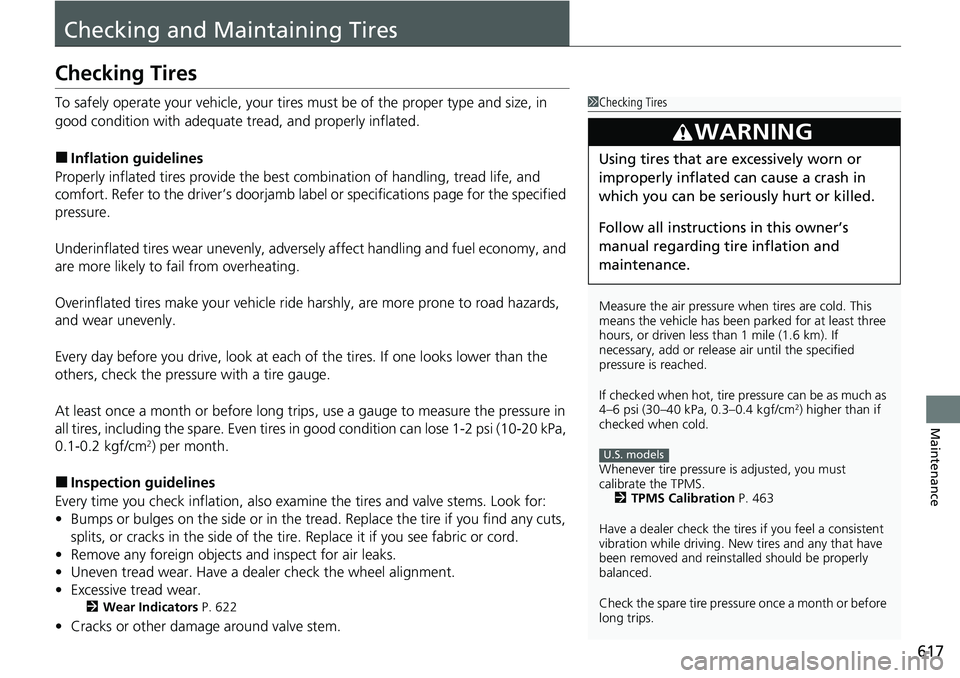
617
Maintenance
Checking and Maintaining Tires
Checking Tires
To safely operate your vehicle, your tires must be of the proper type and size, in
good condition with adequate tread, and properly inflated.
■Inflation guidelines
Properly inflated tires provide the best combination of handling, tread life, and
comfort. Refer to the driver’s doorjamb labe l or specifications page for the specified
pressure.
Underinflated tires wear unev enly, adversely affect handling and fuel economy, and
are more likely to fail from overheating.
Overinflated tires make your vehicle ride ha rshly, are more prone to road hazards,
and wear unevenly.
Every day before you drive, look at each of the tires. If one looks lower than the
others, check the pressure with a tire gauge.
At least once a month or before long trips , use a gauge to measure the pressure in
all tires, including the spare. Even tires in good condition can lose 1-2 psi (10-20 kPa,
0.1-0.2 kgf/cm
2) per month.
■Inspection guidelines
Every time you check inflation, also examine the tires and valve stems. Look for:
• Bumps or bulges on the side or in the tread. Replace the tire if you find any cuts,
splits, or cracks in the side of the tire . Replace it if you see fabric or cord.
• Remove any foreign objects and inspect for air leaks.
• Uneven tread wear. Have a deal er check the wheel alignment.
• Excessive tread wear.
2 Wear Indicators P. 622
•Cracks or other damage around valve stem.
1Checking Tires
Measure the air pressure when tires are cold. This
means the vehicle has been parked for at least three
hours, or driven less than 1 mile (1.6 km). If
necessary, add or releas e air until the specified
pressure is reached.
If checked when hot, tire pressure can be as much as
4–6 psi (30–40 kPa, 0.3–0.4 kgf/cm
2) higher than if
checked when cold.
Whenever tire pressure is adjusted, you must
calibrate the TPMS. 2 TPMS Calibration P. 463
Have a dealer check the tires if you feel a consistent
vibration while driving. Ne w tires and any that have
been removed and reinst alled should be properly
balanced.
Check the spare tire pressu re once a month or before
long trips.
3WARNING
Using tires that are excessively worn or
improperly inflated can cause a crash in
which you can be seriously hurt or killed.
Follow all instruction s in this owner’s
manual regarding ti re inflation and
maintenance.
U.S. models
Page 634 of 700

633
uuCleaning uExterior Care
Continued
Maintenance
Exterior Care
Dust off the vehicle body afte r you drive. Regularly inspect your vehicle for scratches
on painted surfaces. A scratch on a painted surface can result in body rust. If you
find a scratch, promptly repair it.
Wash the vehicle regularly. Wash more fr equently when driving in the following
conditions:
• If driving on roads with road salt.
• If driving in coastal areas.
• If tar, soot, bird droppings, insects, or tree sap are stuck to painted surfaces.
• Make sure to follow the instructions indicated on the automated car wash.
• Fold in the door mirrors.
• For models equipped with automatic intermittent wipers, turn the wipers off.
• Keep sufficient distance between the cleaning nozzle and the vehicle body.
• Take particular care around the windows. Standing too close may cause water to
enter the vehicle interior.
• Do not spray high pressure water direct ly into the engine compartment. Instead,
use low pressure water and a mild detergent.
■Washing the Vehicle
■Using an Automated Car Wash
■Using High Pressure Cleaners
1 Washing the Vehicle
Do not spray water into the air intake vents. It can
cause a malfunction.
Do not spray water onto the fuel fill door directly. A
high-pressure spray ma y cause it to open.
Do not spray water onto the capless unit when the
fuel fill door is open. It ca n cause damage to the fuel
system or engine.
If you need to lift the wiper arms away from the
windshield, first set the wiper arms to the
maintenance position. 2 Changing the Wiper Blade P. 615
Air Intake Vents
Page 640 of 700
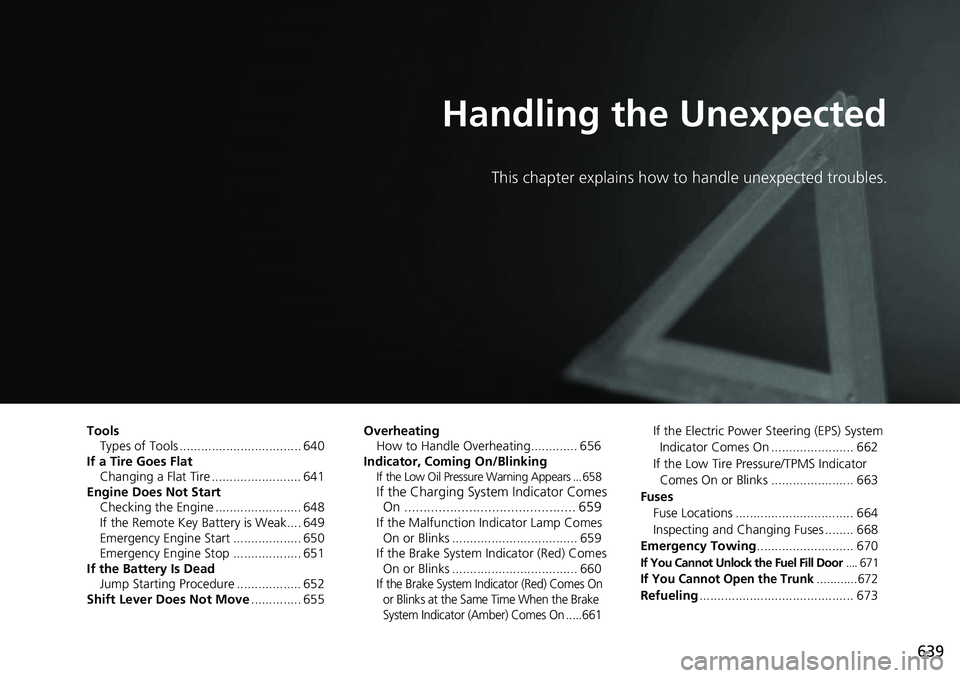
639
Handling the Unexpected
This chapter explains how to handle unexpected troubles.
ToolsTypes of Tools .................................. 640
If a Tire Goes Flat
Changing a Flat Tire ......................... 641
Engine Does Not Start Checking the Engine ........................ 648
If the Remote Key Battery is Weak.... 649
Emergency Engine Start ................... 650
Emergency Engine Stop ................... 651
If the Battery Is Dead Jump Starting Procedure .................. 652
Shift Lever Does Not Move .............. 655Overheating
How to Handle Overheating............. 656
Indicator, Coming On/Blinking
If the Low Oil Pressure Warning Appears ... 658If the Charging System Indicator Comes On ............................................. 659
If the Malfunction Indicator Lamp Comes
On or Blinks ................................... 659
If the Brake System Indicator (Red) Comes
On or Blinks ................................... 660
If the Brake System Indicator (Red) Comes On or Blinks at the Same Time When the Brake
System Indicator (Amber) Comes On .....661
If the Electric Power Steering (EPS) System
Indicator Comes On ....................... 662
If the Low Tire Pressure/TPMS Indicator Comes On or Blinks ....................... 663
Fuses Fuse Locations ................................. 664
Inspecting and Changing Fuses ........ 668
Emergency Towing ........................... 670
If You Cannot Unlock the Fuel Fill Door .... 671
If You Cannot Open the Trunk............672
Refueling........................................... 673
Page 695 of 700
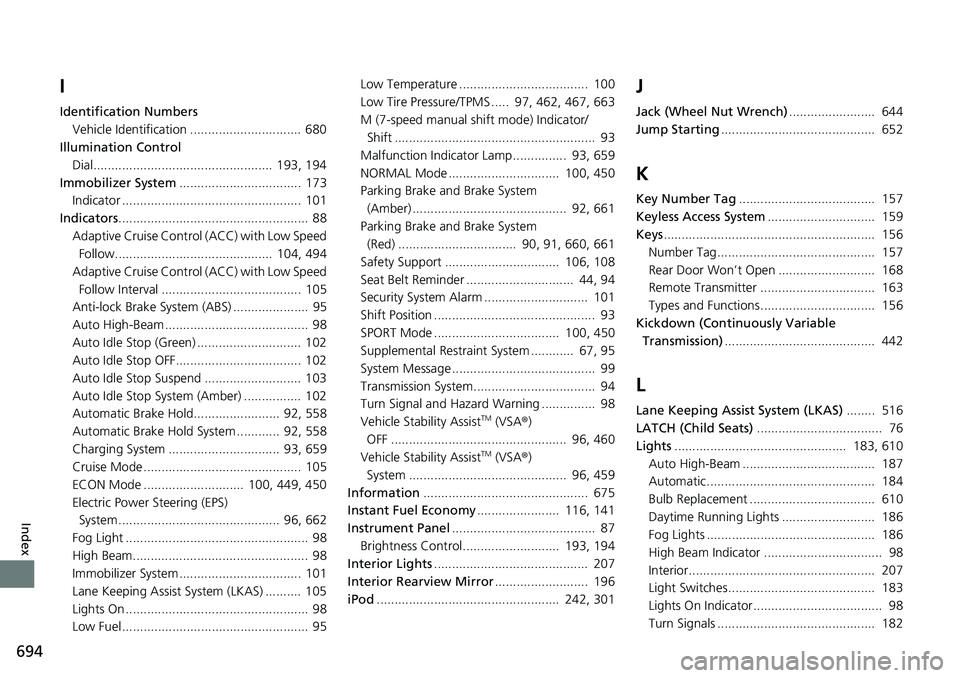
694
Index
I
Identification NumbersVehicle Identification ............................... 680
Illumination Control Dial.................................................. 193, 194
Immobilizer System .................................. 173
Indicator .................................................. 101
Indicators ..................................................... 88
Adaptive Cruise Control (ACC) with Low Speed Follow............................................ 104, 494
Adaptive Cruise Control (ACC) with Low Speed
Follow Interval ....................................... 105
Anti-lock Brake System (ABS) ..................... 95
Auto High-Beam ........................................ 98
Auto Idle Stop (Green) ............................. 102
Auto Idle Stop OFF................................... 102
Auto Idle Stop Suspend ........................... 103
Auto Idle Stop System (Amber) ................ 102
Automatic Brake Hold........................ 92, 558
Automatic Brake Hold System ............ 92, 558
Charging System ............................... 93, 659
Cruise Mode ............................................ 105
ECON Mode ............................ 100, 449, 450
Electric Power Steering (EPS) System ............................................. 96, 662
Fog Light ................................................... 98
High Beam................................................. 98
Immobilizer System .................................. 101
Lane Keeping Assist System (LKAS) .......... 105
Lights On ................................................... 98
Low Fuel .................................................... 95 Low Temperature .................................... 100
Low Tire Pressure/TPMS ..... 97, 462, 467, 663
M (7-speed manual shift mode) Indicator/
Shift ........................................................ 93
Malfunction Indicator Lamp............... 93, 659
NORMAL Mode ............................... 100, 450
Parking Brake a nd Brake System
(Amber) ........................................... 92, 661
Parking Brake a nd Brake System
(Red) ................................. 90, 91, 660, 661
Safety Support ................................ 106, 108
Seat Belt Reminder .............................. 44, 94
Security System Alarm ............................. 101
Shift Position ............................................. 93
SPORT Mode ................................... 100, 450
Supplemental Restraint System ............ 67, 95
System Message ........................................ 99
Transmission System.................................. 94
Turn Signal and Hazard Warning ............... 98
Vehicle Stability Assist
TM (VSA ®)
OFF ................................................. 96, 460
Vehicle Stability Assist
TM (VSA ®)
System ............................................ 96, 459
Information .............................................. 675
Instant Fuel Economy ....................... 116, 141
Instrument Panel ........................................ 87
Brightness Control........................... 193, 194
Interior Lights ........................................... 207
Interior Rearview Mirror .......................... 196
iPod ................................................... 242, 301
J
Jack (Wheel Nut Wrench) ........................ 644
Jump Starting ........................................... 652
K
Key Number Tag ...................................... 157
Keyless Access System .............................. 159
Keys ........................................................... 156
Number Tag............................................ 157
Rear Door Won’t Open ........................... 168
Remote Transmitter ................................ 163
Types and Functions................................ 156
Kickdown (Continuously Variable Transmission) .......................................... 442
L
Lane Keeping Assist System (LKAS) ........ 516
LATCH (Child Seats) ................................... 76
Lights ................................................ 183, 610
Auto High-Beam ..................................... 187
Automatic............................................... 184
Bulb Replacement ................................... 610
Daytime Running Lights .......................... 186
Fog Lights ............................................... 186
High Beam Indicator ................................. 98
Interior.................................................... 207
Light Switches......................................... 183
Lights On Indicator .................................... 98
Turn Signals ............................................ 182